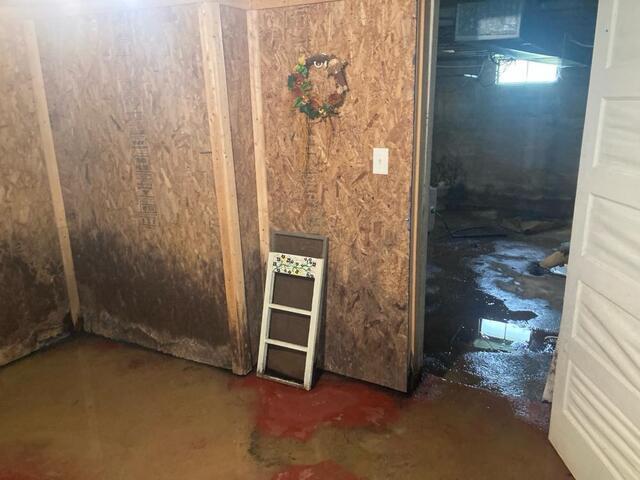Your Fall Basement Maintenance Checklist
What should you check for in your basement during the fall season? As the temperatures begin to cool in the Appalachian region, there are proactive steps you can take to make sure your basement is in peak condition to prevent costly repairs.

Matt's Top Fall Basement Preventive Checklist
Verified by Matt O. - Basement and foundation Solution Specialist with 30+ years of experience

1. Clean gutters and downspouts
2. Clean out window wells
3. Repair broken or cracked windows and frames
4. Check for leaks and moisture
5. Check for mold and odors
6. Check if the sump pump is functioning properly
7. Look and listen for signs of pests
8. Add insulation to keep your basement warm
Outdoor Maintenance
Clean your gutters and downspouts
It's important to keep your gutters and downspouts clear of leaves, sticks, and other debris to manage roof water. And it prevents them from dumping water near your foundation. You should do this year-round, but even more so in the fall months. Don't forget to check for damage and cracks. What you don't want to happen is for water to freeze, clog the gutters or downspouts, and form ice dams. This prevents proper drainage and, once thawed, allows water to seep through your walls. Ignoring this can lead to foundation cracks, shifting, and flooding in the basement.
Check your basement windows and window wells
Basement window wells can be easily forgotten, but they also need to be cleared of leaves and sticks to prevent standing water. Your basement windows should be free of cracks and dampness. If you're seeing either of those, you could be letting in water, moisture, or pests over the winter months. This can also lead to energy waste and higher utility bills. A window well cover can keep out debris and critters, while protecting your windows long-term.
Indoor Maintenance
Check for leaks and moisture
Water and moisture in your basement will lead to all sorts of problems that can be amplified over the winter. Why? Standing water, clogged drains, or water intrusion between the walls will likely freeze over and over again throughout the season. This freezing and thawing cycle causes cracks and fractures that could have a serious impact on your foundation's integrity. The moisture often leads to mold and fungal growth, causing unpleasant odors and health concerns. It can also damage your belongings and organic materials like the wood structure above the basement, including floor joists, sill, plate, rim joists, and subflooring.
Also, remember to check for any leaks from your water heater. This is a fairly common basement problem that can lead to mold, odor, and rot. You can have a pan installed under your water heater to help mitigate this potential problem.
Check for mold and odors
Did you know that 50% of the air you breathe on the first floor comes from the basement? If you smell musty odors coming from the basement, or find mold or mildew on the floors, walls, ceilings, or other belongings, you have a moisture problem that should be addressed. This is a health hazard that can impact your family and pets, and can cause aggravated allergies, asthma, and other health problems. A thorough inspection can pinpoint causes of moisture intrusion and offer solutions to manage these issues.
Check if the sump pump is functioning properly
Test your sump pump and make sure it's working as designed. A float switch should activate your sump pump. A functioning sump pump will pump water through a discharge line to the exterior of the home, at least 10 feet from the foundation wall. If you've experienced the discharge lines freezing, consider calling Alford Foundation and Crawlspace Repair and investing in a protective system that ejects water away from the exterior wall. If your sump pump doesn't have a fail-safe feature for when the power goes out, consider an alternative power source, like a battery-powered backup pump.
Look and listen for signs of pests
Water and moisture attract pests, and so does a warm basement with an easy way to get in. Rodents, bugs, snakes, termites, and other critters can invade your home when the space isn't dry. Pest intrusion is often a sign of high relative humidity or active water intrusion.
Add insulation to keep your basement warm
If you have a really cold basement and first floor in the winter, and see condensation on the walls, HVAC ductwork, or windows in warmer season, your basement likely isn't insulated properly. Consider insulating the perimeter block walls and not the floor system between the between the basement and first floor living space. The most advanced type of insulation will reduce condensation buildup and doesn't use organic materials, where mold can grow. If you have insulation in your basement ceiling, consider removing it and insulating the foundation walls instead.
The goal for the fall is to make sure your basement is prepared for the winter. Precipitation and freezing temperatures add a new level of risk you don't have deal with during other seasons. Following this checklist can ensure the things important to you like your foundation, family's health, home value, and valuables stay in the best shape they can be. If you ever experience a leak, mold, drainage clogging or freezing, reach out to us. We'll inspect, find the problem, and provide a quick estimate.
Frequently Asked Questions (FAQs)
How can I properly seal and waterproof my basement to avoid moisture and mold?
Reach out to a reputable basement waterproofing to get an expert explanation of where potential problem areas may be. If you get an estimate and move forward with a project, a trusted company will first remove any water by adding interior perimeter drainage and installing a sump pump. These two powerhouses work together to move water out and away from your home. Then, they'll dry and filter the air with a high-performance dehumidifier. Finally, if you want to completely transform your basement, they can finish it with vapor barrier on the foundation walls and modern wall paneling and flooring that functions as part of the system to keep your basement dry.
Will my foundation cracks worsen during the winter time?
It’s highly likely. Water is destructive. The freeze-thaw cycle causes many foundation types, like poured concrete, concrete block, or stone walls to settle and crack over time as water infiltrates. If you have ANY water intrusion, consider calling a specialist to provide solutions to mitigate the water intrusion and prevent additional and more costly problems.
Are my gutters, downspouts, and grading keeping water away from the foundation effectively?
Possibly. If your gutters and downspouts are blocked with leaves, sticks, and dirt, or do not discharge at least 10 feet from foundation walls, they could be causing problems. It’s important to clear out gutters and downspouts to keep water flowing away from your foundation. If they have cracks or have been damaged, consider replacing them and adding a guard to protect them from clogging and ice. If the soil surrounding your house is slanting toward your foundation, it's likely leading water directly into your home through the foundation walls. Consider adding clay or dirt to slope the ground away from your foundation, but don't rely on this alone to keep the water out.